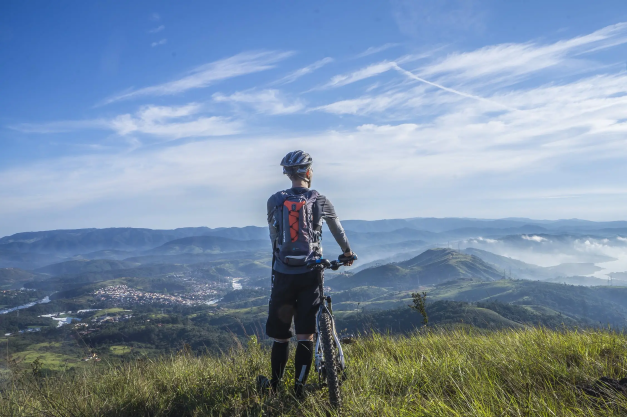APRIL 9,2022
The Best Warm-Up Stretches to Do Before Enjoying NAKTO Biking
Stretching is an essential part of successful biking. A good warm-up stretching routine can help to minimize muscle imbalances, prevent injury and improve your cycling performance. The article below is a pre-ride stretching routine for bikers. Before going on a ride, most experienced bicyclists do some sort of warm-up stretching practice. Unbeknownst to them, however, it is frequently the incorrect kind. If your cycling performance doesn't seem to be improving, have a look at your stretching practice.

Importance of warm-up stretches

You must ensure that your body is prepared and ready to take on the challenge ahead of you before embarking on your long ride. A warm-up can help your body go from a state of rest to one of maximum efficiency. However, you should avoid a long and vigorous warm-up because it can deplete your body and make a long ride more difficult.
Stretching is a form of exercise that is designed to elongate and increase elasticity in targeted muscles and tendons. Stretching helps to warm up or cool down muscles, connective tissues, and joints, increasing range of motion and flexibility, which improves injury healing and prevention.
Riding a bike causes lower back and hamstring pain, and in some long-term cases, spinal posture can be affected as well. If pain relief and increased flexibility aren't enough to convince you to start stretching, consider the long-term repercussions of not doing so, such as spinal misalignment, which can have a negative influence on your quality of life. Stretching should be incorporated into cyclists’' training regimens to lessen the chances of succumbing to such disorders.
How long should you stretch?
Low-intensity biking is often used to warm up for 10 minutes. Begin slowly and gradually increase your speed to a moderate level. It will gradually warm up your body and raise your working heart rate, preparing you physiologically for your lengthy ride. It's also a good opportunity to look over your cycle for signs of wear and tear.
Essential warm up Stretches that are ideal for bikers
Prime your muscles
You should warm up your muscles and get your blood flowing before beginning any workout. This is especially crucial if you've spent most of the day sitting, as joints can stiffen and muscle groups can deactivate. This fast dynamic practice can help you get started before any stretching or biking.
Jumping Jacks and Downward Dog
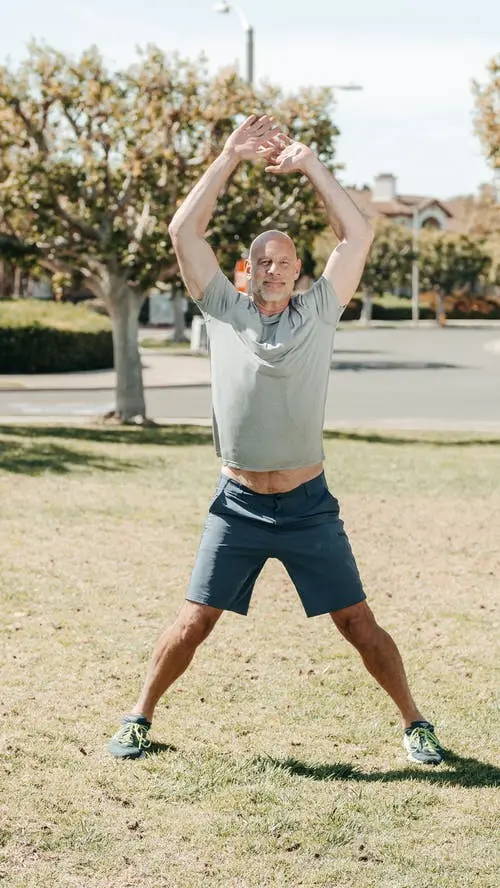
Jumping jacks are an excellent method to warm up your muscles before biking since they incorporate the complete body. Stiffness in the spine and posterior chain can also be relieved by alternating with vigorous downward dogs.
●Complete 1 minute of jumping jacks or jumping rope.
●Move to a pushup position.
●Walk your hands back into a downward dog position. After you feel a stretch, walk your hands back to the starting position. Repeat 3-5 times.
●Repeat the circuit three times.
Mobility and Core
Now that your muscles are warm and your core body temperature has been elevated, you'll need to work on activating the core muscles and increasing the mobility of your spine. Prior to exercise, core activation helps you create maximum power, improves the efficiency of your pedal stroke, and guarantees that muscle groups like your glutes are turned on and ready to fire after long periods of inactivity.
Mobility exercises help you maintain proper biking posture and prevent tension from migrating to areas like the neck, shoulders, and lower back, which can easily wear out during long or difficult rides. While the specific training plan you follow will depend on your tastes or areas of focus, these three exercises are an excellent place to start and will target key biking regions.
Planks

Now that your muscles are warm and your core body temperature has been elevated, you'll need to work on activating the core muscles and increasing the mobility of your spine. Prior to exercise, core activation helps you create maximum power, improves the efficiency of your pedal stroke, and guarantees that muscle groups like your glutes are turned on and ready to fire after long periods of inactivity.
Mobility exercises help you maintain proper biking posture and prevent tension from migrating to areas like the neck, shoulders, and lower back, which can easily wear out during long or difficult rides. While the specific training plan you follow will depend on your tastes or areas of focus, these three exercises are an excellent place to start and will target key biking regions.
Clamshells
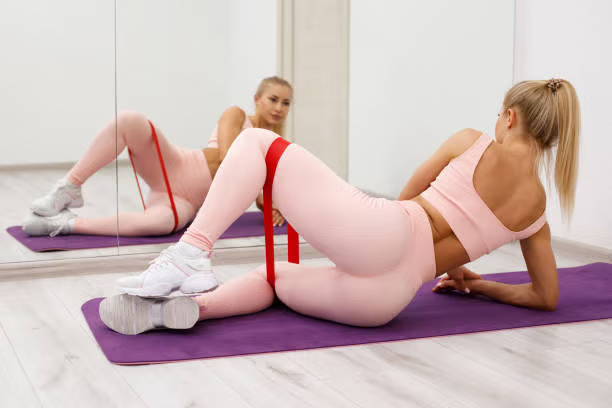
Clamshells are a great way to stimulate your glute muscles and loosen up your hips. Single-leg bridges are a good choice if you prefer a different exercise.
The move
Stack your hips and bend both knees to 90 degrees while lying on your side. Rest your head on your arm for increased comfort. Raise your knees to your chest until your glutes and feet are parallel. Raise the top knee without allowing your hips to spin backward while keeping the bottom leg on the ground, keeping your abs firm and your feet together. On each side, complete 3 sets of 5–8 repetitions.
Seated Spinal Twists

Spinal twists aid mobility by loosening the thoracic and lumbar spines, as well as relieving tension in the piriformis and iliotibial band, both of which are major difficulty regions for cyclists.
The move
Begin by sitting down and straightening both legs in front of you. Bend your right knee and place your right foot on the ground directly outside of your left outer thigh while keeping your left leg straight. Place your left elbow on the outside of your right knee as you rotate your torso to the right. For balance, place your right hand on the ground behind you. Hold this stretch for 30 seconds and then repeat three times on each side.
Doorway Stretch
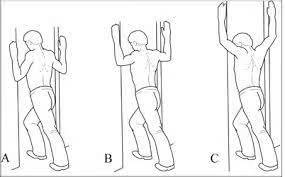
Because you never reach full leg extension while pedaling, your hamstrings are always tense. Side effects include lower back pain and hamstring flexibility. To reduce these common symptoms, work on hamstring flexibility, especially within 10–15 minutes of your ride.
The move
Place one leg flat on the ground in a doorway. Place the opposite leg straight up against the door frame. Bring your buttocks as close to the door frame as you can. Maintain a flat back and hips on the ground. Hold for 20-30 seconds and repeat 3-4 times.
Seated Glute/Piriformis stretch

Your glutes are your workhorses while riding. You rely on your glutes to generate power during strenuous endeavors like hill repeats. If these muscles get exhausted or tight, lower back ache may ensue. This stretch stretches the glutes and piriformis muscles, which link to the backside of your pelvis.
The move
Sit on a chair with one leg crossed and the ankle resting on the opposing knee. Bend forward at the hips, keeping your back as straight as possible, so your shoulders fall toward the shin of the crossed leg. Hold for 20-30 seconds, and repeat 3-4 times with each leg.
Upper Trap Stretch

Because of the continual contraction required to hold up the head in the bent-over position common in road cycling, the upper trapezius might become exhausted. This stretch will release the muscles that go from the base of the skull to the upper shoulders.
The move
Place your left hand behind your left hip and sit on a chair with your head in a neutral position. Apply mild downward pressure with your right hand on the left side of your head, bringing your right ear toward your right shoulder. Slightly rotate your chin toward your right shoulder to isolate the strain higher in the neck. Hold for 10-15 seconds, and repeat 3-4 times on each side.
Revolved belly pose
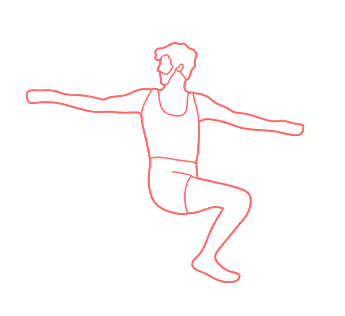
Stiffness and soreness in the lower back are common complaints among cyclists, especially after long or intense exertion. By releasing stress in the lumbar spine, this stretch will help you ease those symptoms.
The move
Begin by lying on your back with your knees bent. Extend your arms to your sides in a straight line. Bring your knees to your chest and then slowly lower them to the right. Place a pillow on the floor and let your knees rest there if you can't lower your knees all the way to the floor. Rep the process on the other side. After you've bent your knees and felt your lower back loosen, extend your lower legs such that your feet reach toward your outstretched palm to increase the stretch. Reps: Hold for 20–30 seconds on each side, then repeat 3–4 times.
Lunge and reach
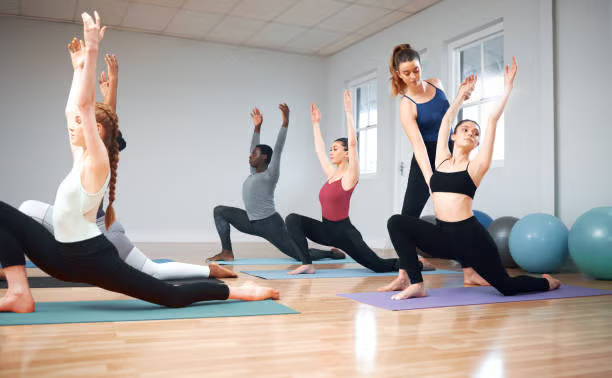
Aggressive riding patterns and the upstroke during the pedaling motion might cause the iliopsoas to become tight. This stretch will help to release tension in your hips' front side.
The move
Place your right knee on the ground and lunge your left leg. Maintain a straight back and reach for the ceiling with your right arm raised straight in the air. Turn your torso away from the knee on which you're kneeling. Replace the leg and arm on the opposite side. Hold for 20-30 seconds and repeat 3-4 times with each leg.
Spin on the bike
It's time to hop on the bike once your muscles have been primed and energized. A fast-spinning routine before your workout might help your legs loosen up and prepare for the heavy work ahead. If you're undertaking a short race like a time trial, keep in mind that your on-bike spinning practice should be longer and more intense. A few minutes of high-cadence spinning should suffice for most other workouts.
●Pedal at a tempo of roughly 90rpm for one minute.
●For 30 seconds, change to a slightly more challenging gear and increase your cadence to 110 rpm or higher.
●Rep four times more.
A racecar driver would not accelerate without first allowing the engine to warm up, and the same is true when riding a motorcycle. Your body shifts up a gear from its resting state when you cycle. If you start pedaling hard from a chilly start, you'll quickly be gasping for air and feeling a burning sensation in your legs.
A solid warm-up turns on your energy-generating system and gets it up and going. To provide energy for cycling, your body begins a process known as glycolysis, which involves the breakdown of stored glucose in your muscles. Because your body needs extra oxygen to do this, your breathing and heart rate rise to ensure that oxygenated blood reaches your muscles. Starting an intense workout without progressive warm-up forces your body to play catch-up on these processes, which it cannot do; instead, you wind yourself in 'oxygen debt,' as your energy system requires more oxygen than your body can provide.
Some Essential Tips
❖Wear a helmet. Although a helmet cannot guarantee your survival, it will always give you a greater chance than going bare-headed. Airbags for your cycle are another option.
❖Bring drinking water.
❖Take precautions against the sun. Apply sunscreen to your entire body, especially the back of your neck. Wear long-sleeved, breathable clothing. Put on your sunglasses.
❖Using recreational trails designed expressly for cyclists can help you avoid some of the more hazardous hazards to cycle riding safety.
❖Keep an eye on the weather forecast. As needed, put on waterproof clothing. You could also bring a small bag with you on every ride to carry lightweight extra clothing and other items.

Conclusion
The basic guideline is that the longer your warmup, the shorter and more intense your workout will be. If you're going on a long, low-intensity ride, the above warmup should be enough. If you plan to ride a hard interval workout, you may need to add extra 5–10 minutes of easy spinning followed by a few more 10-second spin-ups at a high intensity.

